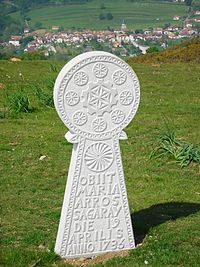
The mythology of the ancient Basques largely did not survive the arrival of Christianity in the Basque Country between the 4th and 12th century AD. Most of what is known about elements of this original belief system is based on the analysis of legends, the study of place names and scant historical references to pagan rituals practised by the Basques.[1]
One main figure of this belief system was the female deity Mari. According to legends collected in the area of Ataun, the other main figure was her consort Sugaar. However, due to the scarcity of the material, it is difficult to say if this would have been the "central pair" of the Basque pantheon. Based on the attributes ascribed to these mythological creatures, this would be considered a chthonic religion as all its characters dwell on earth or below it, with the sky seen mostly as an empty corridor through which the divinities pass.[citation needed]
The main sources for information about non-Christian Basque beliefs are:[2]
|
Main article: List of Basque mythological figures |
| Mythology |
|---|
|
Main article: Urtzi |
Urtzi may have been a Basque mythological figure—a sky god—but may have been merely a word for the sky. There is evidence that can be read as either supporting or contradicting the existence of such a deity. To date, neither theory has been entirely accepted.[3]
The Iberian Peninsula's Indo-European speaking cultures like the Lusitanians and Celtiberians seem to have a significant Basque substrate in their mythologies. This includes the concept of the Enchanted Mouras, which may be based on the Mairu,[4] and the god Endovelicus, whose name may come from proto-Basque words.[5]
After Christianization, the Basques kept producing and importing myths.